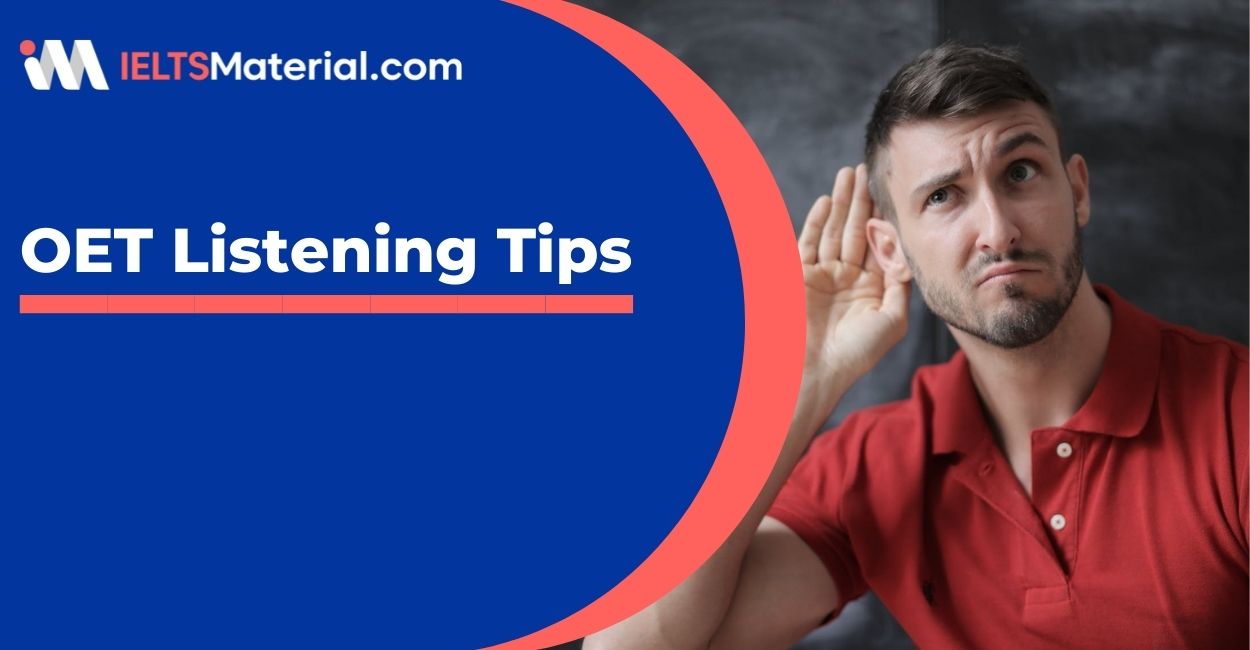OET Listening Tips: Tips to Improve your OET Listening
5 min read
Updated On
-
Copy link
Table of Contents

Limited-Time Offer : Access a FREE 10-Day IELTS Study Plan!
The OET Listening is aimed at evaluating your listening proficiency and this gauges how well of a listener you are when it comes to attending your patients. The Healthcare Department has to adhere to the communication aspect as there is no essence of being in a medical domain without any exchange of information. So, the OET exam analyses the skills of the aspirants to ensure their communication expertise in normal and complicated scenarios.
[do_widget id=custom_html-56]
Here, in this article, we shall learn about some important tips on how to prepare for the Listening subtest of the OET.
OET Listening Tips
Listening is one of the simplest language skills if one can adjust one’s ears to the various accents of a language. Similarly, answering questions in the OET Listening subtest is far less demanding compared to the other three sections. Even then, if you are nervous about how to prepare yourself for the test, use the basic tips given below:
Include different areas of medicine and healthcare in your preparations:
It is typical to be knowledgeable about the topics that you deal with on a regular basis being a nurse, doctor or any other type of medical professional. However, it is important to know about other branches of medicine and healthcare as Listening is similar for all the 12 professions evaluated in OET. So, prior information of these professions like Optometry, Podiatry and Veterinary Science from where questions might be asked will give a remarkable performance in the exam.
Understand the exam format well:
Merely having knowledge of various areas of medicine is not enough for a good OET performance. Candidates need to be comfortable with the format of the exam. This helps them review their answers after each section. Familiarity with the rules and regulations of the OET exam is also vital.
Read the questions before the audio begins:
Reading the questions before listening to the audio recording can prove to be a useful strategy in the OET exam. This will help candidates identify key phrases and words that might help point out the answer while listening to the audio.
Have a thorough knowledge of unique vocabulary:
Medicine and healthcare are fields where the use of unique words and abbreviations is common. Thus, it is crucial to be aware of these phrases and abbreviations used in everyday conversations between doctors and nurses and also to use them properly.
Section-wise Listening Tips for OET
There are three parts to the OET Listening test: Part A, B and C. Part A of the Listening test requires candidates to identify specific information during a medical consultation. Using this information, candidates are required to complete notes. Part B involves listening to various types of audio extracts that can range from team briefings and handovers to dialogue between two healthcare professionals.
After listening to these multiple recordings, candidates are required to answer one multiple-choice question for each audio recording. In Part C, candidates must listen to two recorded interviews or presentations and answer six multiple-choice questions for each extract. Given below are some tips for each part of the OET Listening test.
Listening Tips for OET Listening Part A
In Part A of the Occupational English language test, candidates are asked to gather specific patient information. In this part, the healthcare professional mainly asks questions and the patient answers. Here are some tips candidates can implement in this part.
- Candidates can take running notes when listening to the audio in order to retain important information and not waste time recalling minute details.
- Grammatical accuracy is not the most vital aspect of the answers. Examiners are known to overlook minor errors and spelling mistakes.
- It is essential to sharpen your listening skills for this part of the listening test. The answers to the questions in Part A of the OET listening test have to be precisely the same as the audio recording. Synonyms cannot be used as answers in this part.
- Try to predict the kind of information that is needed to fill the gap beforehand. This can be done by reading the question carefully before listening to the audio recording. Such a technique helps you stay ahead and be time-efficient.
Listening tips for OET Listening Part B
In Part B of the OET Listening test, candidates need to understand the theme of the dialogue between the healthcare professional and their patient or group of colleagues. The questions in this part can be aimed at identifying details and ascertaining opinions and they can also be straightforward. Given below are some tips candidates can implement in this part.
- Read the context sentence carefully. Useful information such as the speaker’s profession and the speaker’s audience is mentioned in this sentence. Also, read all the possible options for the answer and notice the differences between each option.
- As this part aims to identify the gist of the communication between the healthcare professional and their audience, it is vital to listen to the entire audio carefully.
- One of the best ways to identify the correct answer is to apply a process of elimination. After hearing the recording, striking out the irrelevant information can help candidates reach the answer more quickly.
- Approaching the questions more efficiently for the candidate can also help efficient use of time. For example, candidates can convert incomplete questions like “The trainee thinks the cause of the problem was ____” into complete questions like “What was the cause of the problem according to the trainee?” for better understanding.
Listening tips for OET Listening Part C
In Part C of the OET Listening test, candidates are required to identify whether the question includes a direct or an inferred meaning.
For direct meaning questions, candidates have to understand the main theme/idea of the extract, whereas in the inferred meaning questions, deeper meaning to the audio extract needs to be found and questions are related to the speaker’s attitude. Here are some tips candidates can implement in this part.
- Using a top-down approach can be helpful in this part of the OET Listening test. This approach refers to the ability of our minds to have logical expectations about a new text after knowing the topic of discussion. For example, knowing the topic being discussed in an audio recording before hearing it will help us identify and make more sense of the new information.
- Listen for signposting language while listening to the presentation instead of the interview. Signposting language can be used as a guide to understanding the course or development of a discussion which makes the understanding or identifying information much more manageable.
- Practice listening to interviews and presentations online. This will tremendously help you improve your listening skills, especially for Part C of the OET listening test. These interviews and presentations help candidates come across various types of accents and also numerous examples of signposting language.
- Interview questions can help us identify when the next question is going to be asked. Since, in Part C, audio recordings are either presentations or interviews, candidates can use the interview questions as a guide to understanding the beginning of the next question. This technique helps candidates navigate the recording successfully and avoid missing important details and information.
The OET Listening test can be a tough nut to crack if an individual’s listening abilities are not up to standard. Hopefully, the mentioned tips on OET Listening and its different parts will help you prepare for the test substantially.
All the best!
Frequently Asked Questions
What is the OET Listening task comprises?
How do I start the preparation for the OET Listening task?
What are the best ways to prepare for the OET Listening part A?
What are the best ways to prepare for the OET Listening part B?
What are the best ways to prepare for the OET Listening part C?
Other OET Exam Related Articles

Start Preparing for IELTS: Get Your 10-Day Study Plan Today!
Recent Articles

Kasturika Samanta

Haniya Yashfeen

Kasturika Samanta





Post your Comments